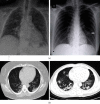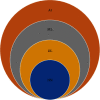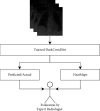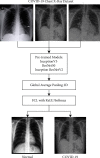Artificial Intelligence and Deep Learning Assisted Rapid Diagnosis of COVID-19 from Chest Radiographical Images: A Survey
- PMID: 36304775
- PMCID: PMC9581633
- DOI: 10.1155/2022/1306664
Artificial Intelligence and Deep Learning Assisted Rapid Diagnosis of COVID-19 from Chest Radiographical Images: A Survey
Abstract
Artificial Intelligence (AI) has been applied successfully in many real-life domains for solving complex problems. With the invention of Machine Learning (ML) paradigms, it becomes convenient for researchers to predict the outcome based on past data. Nowadays, ML is acting as the biggest weapon against the COVID-19 pandemic by detecting symptomatic cases at an early stage and warning people about its futuristic effects. It is observed that COVID-19 has blown out globally so much in a short period because of the shortage of testing facilities and delays in test reports. To address this challenge, AI can be effectively applied to produce fast as well as cost-effective solutions. Plenty of researchers come up with AI-based solutions for preliminary diagnosis using chest CT Images, respiratory sound analysis, voice analysis of symptomatic persons with asymptomatic ones, and so forth. Some AI-based applications claim good accuracy in predicting the chances of being COVID-19-positive. Within a short period, plenty of research work is published regarding the identification of COVID-19. This paper has carefully examined and presented a comprehensive survey of more than 110 papers that came from various reputed sources, that is, Springer, IEEE, Elsevier, MDPI, arXiv, and medRxiv. Most of the papers selected for this survey presented candid work to detect and classify COVID-19, using deep-learning-based models from chest X-Rays and CT scan images. We hope that this survey covers most of the work and provides insights to the research community in proposing efficient as well as accurate solutions for fighting the pandemic.
Copyright © 2022 Deepak Sinwar et al.
Conflict of interest statement
The authors declare that they have no conflicts of interest to report regarding this study.
Figures










Similar articles
-
Diagnosis of COVID-19 Using Machine Learning and Deep Learning: A Review.Curr Med Imaging. 2021;17(12):1403-1418. doi: 10.2174/1573405617666210713113439. Curr Med Imaging. 2021. PMID: 34259149 Review.
-
COVID-19 Pneumonia Diagnosis Using a Simple 2D Deep Learning Framework With a Single Chest CT Image: Model Development and Validation.J Med Internet Res. 2020 Jun 29;22(6):e19569. doi: 10.2196/19569. J Med Internet Res. 2020. PMID: 32568730 Free PMC article.
-
A survey of machine learning-based methods for COVID-19 medical image analysis.Med Biol Eng Comput. 2023 Jun;61(6):1257-1297. doi: 10.1007/s11517-022-02758-y. Epub 2023 Jan 28. Med Biol Eng Comput. 2023. PMID: 36707488 Free PMC article. Review.
-
Combating COVID-19 Crisis using Artificial Intelligence (AI) Based Approach: Systematic Review.Curr Top Med Chem. 2024;24(8):737-753. doi: 10.2174/0115680266282179240124072121. Curr Top Med Chem. 2024. PMID: 38318824
-
Review on Diagnosis of COVID-19 from Chest CT Images Using Artificial Intelligence.Comput Math Methods Med. 2020 Sep 26;2020:9756518. doi: 10.1155/2020/9756518. eCollection 2020. Comput Math Methods Med. 2020. PMID: 33014121 Free PMC article. Review.
Cited by
-
Computational Intelligence-Based Disease Severity Identification: A Review of Multidisciplinary Domains.Diagnostics (Basel). 2023 Mar 23;13(7):1212. doi: 10.3390/diagnostics13071212. Diagnostics (Basel). 2023. PMID: 37046431 Free PMC article. Review.
-
Classification of Severity of Lung Parenchyma Using Saliency and Discrete Cosine Transform Energy in Computed Tomography of Patients With COVID-19.Int J Telemed Appl. 2025 Jan 6;2025:4420410. doi: 10.1155/ijta/4420410. eCollection 2025. Int J Telemed Appl. 2025. PMID: 39816708 Free PMC article.
References
-
- Cohen J. P., Morrison P., Dao L. COVID-19 Image Data Collection. https://arxiv.org/abs/2003.11597 .
-
- Zhao J., Zhang Y., He X., Xie P. COVID-CT-Dataset: a CT scan dataset about COVID-19. 2020. https://arxiv.org/abs/2003.13865 .
Publication types
MeSH terms
LinkOut - more resources
Full Text Sources
Medical
Miscellaneous
